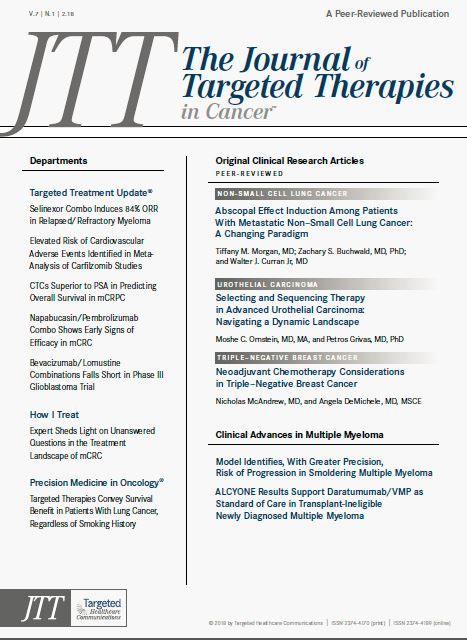Abscopal Effect Induction Among Patients With Metastatic Non-Small Cell Lung Cancer
The prognosis for patients with metastatic non–small cell lung cancer (NSCLC) is poor. However, with recent trials showing improved overall survival with checkpoint inhibitors compared with standard chemotherapy, disease management is changing.
Walter J. Curran Jr., MD
Abstract
The prognosis for patients with metastatic nonsmall cell lung cancer (NSCLC) is poor. However, with recent trials showing improved overall survival with checkpoint inhibitors compared with standard chemotherapy, disease management is changing. Radiation therapy (RT) is typically reserved for the palliative setting in those patients with metastatic disease because it has been thought to only have effects within the treatment field. With increasing evidence of the immunomodulatory effect of RT, termed the abscopal effect, its systemic effects are being actively investigated. The current understanding of the abscopal effect, and how it can be exploited in those with metastatic NSCLC, will be discussed.
Introduction
Metastatic NSCLC and Checkpoint Inhibitors
For patients diagnosed with metastatic nonsmall cell lung cancer (NSCLC) without a driver mutation, there has been little therapeutic progress in the past 2 decades.1-3Recent positive results in immunotherapy trials for these patients, however, have begun to transform the management of this disease. As a hallmark of cancer, tumors can develop immune resistance mechanisms via dysregulation of checkpoint protein expression, allowing malignant cells to escape immune destruction.4-6Certain immunotherapeutic approaches allow tumor immunologic tolerance to be overcome and can facilitate a potent anti-tumor T-cell response.7-9A promising class of cancer immunotherapy agents is composed of the immune checkpoint inhibitors, including antibodies against CTLA-4 and the PD-1 pathway. These agents have been found to be active against many tumor types, including melanoma, renal cell carcinoma, NSCLC, and bladder cancer.7,10-12
In NSCLC, recent data suggest those patients with high levels of PD-L1 expression may respond better to checkpoint inhibitors than those with lower levels. Four recent phase III trials have shown that patients with recurrent or stage IV NSCLC and progression after treatment with a platinum-based chemotherapy have improved overall survival (OS) after receiving nivolumab (antiPD-1), pembrolizumab (anti–PD-1), or atezolizumab (anti–PD-L1) rather than docetaxel chemotherapy. These benefits appear related to PD-L1 expression level in the tumor. The checkpoint inhibitors also had a more favorable safety profile than docetaxel.13-16In the first-line setting, randomized results have been less consistent. The CheckMate 026 trial demonstrated no difference in progression-free survival (PFS) or OS outcome between patients with newly diagnosed stage IV NSCLC treated with nivolumab and those treated with platinum-based chemotherapy.17
In contrast, a phase III trial (KEYNOTE-024) showed significantly improved PFS and OS among such patients treated with pembrolizumab compared with physician’s choice platinum-based chemotherapy as first-line therapy; all patients had PD-L1 expression on at least 50% of tumor cells. Again, the immunotherapy arm experienced less toxicity.18Given this result, pembrolizumab monotherapy was approved by the FDA for the treatment of patients with newly diagnosed metastatic NSCLC with PD-L1 expression ≥50%, and pembrolizumab, nivolumab, and atezolizumab are approved as second-line treatments for patients with metastatic NSCLC.
Immunomodulatory Effect of Radiation
How radiation therapy (RT) fits into this changing landscape remains an open question. For patients with metastatic disease, radiation is typically used for palliation or prevention of symptoms. It is becoming more common at many institutions to offer selected patients with good performance status and low-volume metastatic disease ablative doses of RT to sites of so-called “oligometastatic” disease in the hopes of delaying disease progression and even extending survival.19,20With image-guided RT, along with other technological advances, it is often possible to deliver ablative doses of RT to metastatic foci with minimal damage to surrounding normal tissues. This can be a reasonable treatment option for selected patients with metastatic disease, as a short RT treatment course may minimize the time a patient is off systemic therapy.
RT-induced DNA damage of cells within the irradiated target volume has been considered to be the main mechanism of cell-killing by RT. There is now increasing anecdotal evidence of an RT-induced immune effect. Grills et al published a retrospective review of 124 patients who received either stereotactic body radiation therapy (SBRT) or a wedge resection for stage I NSCLC.21In this study, there was a borderline statistically significant (P = .07) difference in local tumor recurrence rate favoring SBRT. Interestingly, there was also a lower regional nodal recurrence rate in the SBRT group (4% vs 18%). Given that regional nodes were not included in the RT field, this may be an example of an immune response to RT outside the irradiated volume.
While not a new concept, the immunomodulatory effect of radiation has gained traction over recent years and is being actively investigated.22,23First hypothesized by Mole et al in 1953, this has been termed the abscopal effect and refers to a phenomenon in which localized RT leads to tumor response distant from the site of radiation.24-26While the abscopal effect has not been fully elucidated, it is theorized that RT leads to the liberation of tumor antigens and the production of damage-associated molecular patterns, which lead to the maturation of dendritic cells and T-cell priming in an immunogenic context.27Radiation can produce epitope spreading, increasing the diversity of the T-cell receptor repertoire of intratumoral T-cells and broadening the antitumor response.28This can induce and improve an immune response specific to tumor cells.29
RT has also been found to increase T-cell infiltration of the tumor30; the importance of T-cells for a robust response to RT was first described by Slone et al in 1979.31They showed that after immunocompetent and immunocompromised mice with fibrosarcoma were treated with RT, the T-celldeficient mice were less responsive to RT, and they required increasing doses to achieve the same tumor control dose 50% seen in immunocompetent mice. This was subsequently redemonstrated in preclinical and clinical studies.23,32In one of the earliest clinical reports, the abscopal effect was described in a patient with lymphoma.33It was subsequently reported among patients with solid tumors, including NSCLC.34Golden et al described the case of a male with metastatic NSCLC that had progressed through multiple lines of systemic therapy and a definitive dose of RT to his primary thoracic tumor. e developed progressive liver and bone metastases and was started on ipilimumab. RT was delivered to 1 of his hepatic lesions, 30 Gy in 5 fractions, in hopes of triggering both a tumor response and an abscopal effect. The patient had an objective response at all disease sites and had no evidence of disease a year after treatment.35
Although the abscopal effect has been seen when treatment for NSCLC consists of radiation alone, it is thought to occur with greater frequency when radiation is combined with such agents as checkpoint inhibitors.35-37In a subgroup analysis of patients with advanced NSCLC treated on KEYNOTE-001 at a single institution, Shaverdian et al found that patients who received RT prior to their first cycle of pembrolizumab had longer PFS and OS compared with those who did not receive RT. For patients who received extracranial RT, OS was 11.6 months versus 5.3 months, respectively; PFS was 6.3 months versus 2.0 months, respectively. Frequency of grade 3 or greater pulmonary toxicity was not significantly different between those who received thoracic radiation (TRT) and those who did not.38Further, a retrospective cohort study by Hwang and colleagues found that in patients with metastatic lung cancer (95% NSCLC, 5% small cell lung cancer) managed with PD-1/PD-L1 therapy, those who received TRT trended toward improvement in OS compared with those who did not (P = .06). This was despite the fact that patients in the TRT group had fewer targetable mutations. Further, adverse events were similar in the TRT group and no-TRT group.39The sequencing of these treatments is a topic of continued investigation.
Ablative doses of radiation have been associated with an abscopal effect more frequently than standard fractionation.23,40In a study by Lee et al using B16 melanoma-engrafted mice, it was found that ablative doses of RT are more likely to trigger an abscopal reaction than conventional RT fractionation.23Dewan and colleagues showed in preclinical studies that only a hypofractionated regimen of RT was successful at triggering the abscopal effect, while a single-fraction regimen was not, when both regimens were delivered with antiCTLA-4.41In addition, delivering 8 Gy × 3 fractions was found to be more effective than 6 Gy × 5 fractions. Further, a recent meta-analysis found that in preclinical models, the rate of occurrence of the abscopal effect increases with biologically equivalent dose (BED).40Specifically, the probability of triggering the abscopal effect is 50% with a BED of 60 Gy. Despite these intriguing data, however, there is currently no clear consensus on the optimal dose fractionation to trigger an immune response.42
Conclusions
Though previously thought to be primarily a therapy targeting cancer within its treatment field, RT has been shown to have systemic effects. Learning how to exploit these effects remains key to using this modality in a clinically meaningful way for patients with metastatic NSCLC. The combination of RT and checkpoint inhibitors has demonstrated synergy as RT can recruit näive T cells to the antitumor immune response, while antiPD-1 therapy can reinvigorate already primed, but exhausted, tumor-specific T cells.28,43Although this combination has great promise in improving disease-free survival in patients with NSCLC, more work needs to be done to determine which patients can be expected to respond to this therapy. For instance, is the degree of PD-L1 expression predictive of the abscopal effect? What is the optimal RT fractionation? Which metastatic metastatic site should be chosen for focal irradiation? What is the ideal treatment volume? And what is the best timing of delivery of immunotherapy in relation to RT? Several open clinical trials may provide answers to these questions.
References
- Scagliotti GV, Parikh P, von Pawel J, et al. Phase III study comparing cisplatin plus gemcitabine with cisplatin plus pemetrexed in chemotherapy-naive patients with advanced-stage non-small-cell lung cancer.J Clin Oncol. 2008;26(21):3543-3551. doi: 10.1200/JCO.2007.15.0375.
- Paz-Ares L, Mezger J, Ciuleanu TE, et al; INSPIRE investigators. Necitumumab plus pemetrexed and cisplatin as first-line therapy in patients with stage IV non-squamous non-small-cell lung cancer (INSPIRE): an open-label, randomised, controlled phase 3 study.Lancet Oncol. 2015;16(3):328-337. doi: 10.1016/S1470- 2045(15)70046-X.
- Fossella FV, DeVore R, Kerr RN, et al. Randomized phase III trial of docetaxel versus vinorelbine or ifosfamide in patients with advanced non-small-cell lung cancer previously treated with platinum-containing chemotherapy regimens. the TAX 320 Non-Small Cell Lung Cancer Study Group.J Clin Oncol. 2000;18(12):2354-2362.
- Gajewski TF, Meng Y, Blank C, et al. Immune resistance orchestrated by the tumor microenvironment.Immunol Rev. 2006;213:131-145.
- Smyth MJ, Godfrey DI, Trapani JA. A fresh look at tumor immunosurveillance and immunotherapy.Nat Immunol.2001;2(4):293-299.
- Hanahan D, Weinberg RA. The hallmarks of cancer.Cell. 2000;100(1):57-70.
- Sharma P, Allison JP. The future of immune checkpoint therapy.Science. 2015;348(6230):56-61. doi: 10.1126/science.aaa8172.
- Pardoll DM. The blockade of immune checkpoints in cancer immunotherapy.Nat Rev Cancer. 2012;12(4):252-264. doi: 10.1038/nrc3239.
- Smyth MJ, Ngiow SF, Ribas A, Teng MW. Combination cancer immunotherapies tailored to the tumour microenvironment.Nat Rev Clin Oncol. 2016;13(3):143-158. doi: 10.1038/nrclinonc.2015.209.
- Topalian SL, Hodi FS, Brahmer JR, et al. Safety, activity, and immune correlates of antiPD-1 antibody in cancer.N Engl J Med. 2012;366(26):2443-2454. doi: 10.1056/NEJMoa1200690..
- Powles T, Eder JP, Fine GD, et al. MPDL3280A (antiPD-L1) treatment leads to clinical activity in metastatic bladder cancer.Nature. 2014;515(7528):558-562. doi: 10.1038/nature13904.
- Brahmer JR, Tykodi SS, Chow LQ, et al. Safety and activity of antiPD-L1 antibody in patients with advanced cancer.N Engl J Med. 2012;366(26):2455-2465. doi: 10.1056/NEJMoa1200694.
- Brahmer J, Reckamp KL, Baas P, et al. Nivolumab versus docetaxel in advanced squamous-cell non-small-cell lung cancer.N Engl J Med. 2015;373(2):123-135. doi: 10.1056/NEJMoa1504627.
- Borghaei H, Paz-Ares L, Horn L, et al. Nivolumab versus docetaxel in advanced nonsquamous non-small-cell lung cancer.N Engl J Med. 2015;373(17):1627-1639. doi: 10.1056/NEJMoa1507643.
- Rittmeyer A, Barlesi F, Waterkamp D, et al; OAK Study Group. Atezolizumab versus docetaxel in patients with previously treated non-small-cell lung cancer (OAK): a phase 3, open-label, multicentre randomised controlled trial.Lancet. 2017;389(10066):255-265. doi: 10.1016/S0140-6736(16)32517-X..
- Herbst RS, Baas P, Kim DW, et al. Pembrolizumab versus docetaxel for previously treated, PD-L1-positive, advanced non-small-cell lung cancer (KEYNOTE-010): a randomised controlled trial.Lancet. 2016;387(10027):1540-1550. doi: 10.1016/ S0140-6736(15)01281-7.
- Carbone DP, Reck M, Paz-Ares L, et al; CheckMate 026 Investigators. First-line nivolumab in stage IV or recurrent non-small-cell lung cancer.N Engl J Med. 2017;376(25):2415-2426. doi: 10.1056/NEJMoa1613493..
- Reck M, Rodriguez-Abreu D, Robinson AG, et al; KEYNOTE-024 Investigators. Pembrolizumab versus chemotherapy for PD-L1-positive non-small-cell lung cancer.N Engl J Med. 2016;375(19):1823-1833.
- Iyengar P, Kavanagh BD, Wardak Z, et al. Phase II trial of stereotactic body radiation therapy combined with erlotinib for patients with limited but progressive metastatic non-small-cell lung cancer.J Clin Oncol. 2014;32(34):3824-3830. doi: 10.1200/JCO.2014.56.7412.
- Gomez DR, Blumenschein GR Jr, Lee JJ, et al. Local consolidative therapy versus maintenance therapy or observation for patients with oligometastatic non-small-cell lung cancer without progression after first-line systemic therapy: a multicentre, randomised, controlled, phase 2 study.Lancet Oncol. 2016;17(12):1672-1682. doi: 10.1016/S1470-2045(16)30532-0.
- Grills IS, Mangona VS, Welsh R, et al. Outcomes after stereotactic lung radiotherapy or wedge resection for stage I non-small-cell lung cancer.J Clin Oncol.2010;28(6):928-935. doi: 10.1200/JCO.2009.25.0928.
- Formenti SC, Demaria S. Systemic effects of local radiotherapy.Lancet Oncol.2009;10(7):718-726. doi: 10.1016/S1470-2045(09)70082-8.
- Lee Y, Auh SL, Wang Y, et al. Therapeutic effects of ablative radiation on localtumor require CD8+ T cells: changing strategies for cancer treatment.Blood. 2009;114(3):589-595. doi: 10.1182/blood-2009-02-206870.
- Demaria S, Ng B, Devitt ML, et al. Ionizing radiation inhibition of distant untreated tumors (abscopal effect) is immune mediated.Int J Radiat Oncol Biol Phys. 2004;58(3):862-870.
- Ng J, Dai T. Radiation therapy and the abscopal effect: a concept comes of age.Ann Transl Med. 2016;4(6):118. doi: 10.21037/atm.2016.01.32.
- Mole RH. Whole body irradiation; radiobiology or medicine?Br J Radiol.1953;26(305):234-241.
- Vatner RE, Cooper BT, Vanpouille-Box C, et al. Combinations of immunotherapy and radiation in cancer therapy.Front Oncol. 2014;4:325. doi: 10.3389/ fonc.2014.00325.
- Twyman-Saint Victor C, Rech AJ, Maity A, et al. Radiation and dual checkpoint blockade activate non-redundant immune mechanisms in cancer.Nature. 2015;520(7547):373-377. doi: 10.1038/nature14292.
- Hodge JW, Guha C, Neefjes J, Gulley JL. Synergizing radiation therapy and immunotherapy for curing incurable cancers. opportunities and challenges.Oncology(Williston Park). 2008;22(9):1064-1070; discussion 1075,1080-1061,1084.
- Demaria S, Formenti SC. Role of T lymphocytes in tumor response to radiotherapy.Front Oncol. 2012;2:95. doi: 10.3389/fonc.2012.00095.
- Stone HB, Peters LJ, Milas L. Effect of host immune capability on radiocurability and subsequent transplantability of a murine fibrosarcoma.J Natl Cancer Inst. 1979;63(5):1229-1235.
- Restifo NP, Dudley ME, Rosenberg SA. Adoptive immunotherapy for cancer: harnessing the T cell response.Nat Rev Immunol. 2012;12(4):269-281. doi: 10.1038/nri3191.
- Nobler MP. The abscopal effect in malignant lymphoma and its relationship to lymphocyte circulation.Radiology. 1969;93(2):410-412.
- Siva S, MacManus MP, Martin RF, Martin OA. Abscopal effects of radiation therapy: a clinical review for the radiobiologist.Cancer Lett.2015;356(1):82-90. doi: 10.1016/j.canlet.2013.09.018.
- Golden EB, Demaria S, Schiff PB, et al. An abscopal response to radiation and ipilimumab in a patient with metastatic non-small cell lung cancer.Cancer Immunol Res. 2013;1(6):365-372. doi: 10.1158/2326-6066.CIR-13-0115.
- Siva S, Callahan J, MacManus MP, et al. Abscopal [corrected] effects after conventional and stereotactic lung irradiation of non-small-cell lung cancer.J Thorac Oncol. 2013;8(8):e71-e72. doi: 10.1097/JTO.0b013e318292c55a.
- Demaria S, Kawashima N, Yang AM, et al. Immune-mediated inhibition of metastases after treatment with local radiation and CTLA-4 blockade in a mouse model of breast cancer.Clin Cancer Res.2005;11(2 Pt 1):728-734.
- Shaverdian N, Lisberg AE, Bornazyan K, et al. Previous radiotherapy and the clinical activity and toxicity of pembrolizumab in the treatment of non-smallcell lung cancer: a secondary analysis of the KEYNOTE-001 phase 1 trial.Lancet Oncol. 2017;18(7):895-903. doi: 10.1016/S1470-2045(17)30380-7.
- Hwang WL, Niemierko A, Hwang KL, et al. Clinical outcomes in patients with metastatic lung cancer treated with PD-1/PD-L1 inhibitors and thoracic radiotherapy [published online September 27, 2017].JAMA Oncol.doi: 10.1001/jamaoncol.2017.3808.
- Marconi R, Strolin S, Bossi G, Strigari L. A meta-analysis of the abscopal effect in preclinical models: is the biologically effective dose a relevant physical trigger?PLoS One.2017;12(2):e0171559. doi: 10.1371/journal.pone.0171559.
- Dewan MZ, Galloway AE, Kawashima N, et al. Fractionated but not singledose radiotherapy induces an immune-mediated abscopal effect when combined with anti-CTLA-4 antibody.Clin Cancer Res. 2009;15(17):5379-5388. doi: 10.1158/1078-0432.CCR-09-0265.
- Buchwald ZS, Efstathiou JA. Immunotherapy and radiation a new combined treatment approach for bladder cancer?Bladder Cancer.2015;1(1):15-27. doi: 10.3233/BLC-150014.
- Barber DL, Wherry EJ, Masopust D, et al. Restoring function in exhausted CD8 T cells during chronic viral infection.Nature. 2006;439(7077):682-687.














